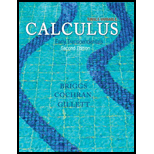
Evaluating series Evaluate each series or state that it diverges.
71.
Trending nowThis is a popular solution!

Chapter 8 Solutions
Single Variable Calculus: Early Transcendentals Plus MyLab Math with Pearson eText -- Access Card Package (2nd Edition) (Briggs/Cochran/Gillett Calculus 2e)
Additional Math Textbook Solutions
College Algebra (7th Edition)
Using and Understanding Mathematics: A Quantitative Reasoning Approach (6th Edition)
A Problem Solving Approach To Mathematics For Elementary School Teachers (13th Edition)
Basic Business Statistics, Student Value Edition
Thinking Mathematically (6th Edition)
A First Course in Probability (10th Edition)
- Find area of the secarrow_forwardi need help pleasearrow_forwardQuestion 4 Find an equation of (a) The plane through the point (2, 0, 1) and perpendicular to the line x = y=2t, z=3+4t. 3t, (b) The plane through the point (3, −2, 8) and parallel to the plane z = x+y. (c) The plane that contains the line x = parallel to the plane 5x + 2y + z = 1. 1+t, y2t, z = 43t and is (d) The plane that passes through the point (1,2,3) and contains the line x = 3t, y=1+t, and z = 2 – t. (e) The plane that contains the lines L₁ : x = 1 + t, y = 1 − t, z = = L2 x 2s, y = s, z = 2. 2t andarrow_forward
- can you explain why the correct answer is Aarrow_forwardSee image for questionarrow_forwardFor this question, refer to the a1q4.py Python code that follows the assignment, as well as the dataprovided after the assignment.(a) Modify the code presented to plot the data from the two separate sets of information(from each region).(b) For each population of squirbos, let ` be the length of their front claws and s the mass ofthe skull. Determine for what value of m the s is isometric to `m. Justify it with your log − log plotsfrom (a) and suitable sketched lines.(c) What do you notice about the correlus striatus on your plot?(d) What historically might explain their situation?arrow_forward
 College AlgebraAlgebraISBN:9781305115545Author:James Stewart, Lothar Redlin, Saleem WatsonPublisher:Cengage Learning
College AlgebraAlgebraISBN:9781305115545Author:James Stewart, Lothar Redlin, Saleem WatsonPublisher:Cengage Learning
 Algebra and Trigonometry (MindTap Course List)AlgebraISBN:9781305071742Author:James Stewart, Lothar Redlin, Saleem WatsonPublisher:Cengage Learning
Algebra and Trigonometry (MindTap Course List)AlgebraISBN:9781305071742Author:James Stewart, Lothar Redlin, Saleem WatsonPublisher:Cengage Learning College Algebra (MindTap Course List)AlgebraISBN:9781305652231Author:R. David Gustafson, Jeff HughesPublisher:Cengage Learning
College Algebra (MindTap Course List)AlgebraISBN:9781305652231Author:R. David Gustafson, Jeff HughesPublisher:Cengage Learning Algebra & Trigonometry with Analytic GeometryAlgebraISBN:9781133382119Author:SwokowskiPublisher:Cengage
Algebra & Trigonometry with Analytic GeometryAlgebraISBN:9781133382119Author:SwokowskiPublisher:Cengage





